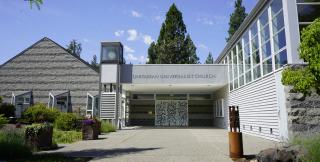Advertisement
The dramatic front doors of the Unitarian Universalist Church of Spokane, Washington, are one of the first clues that you are entering a special space. Composed of porcelain enamel on steel, the boldly patterned black and white doors were designed by well-known artist and member Harold Balazs (1928–2017). They’re just one of the artful touches throughout the building and grounds that make it memorable.
In the sanctuary, light spills in from high windows on the left and right. A large fabric art banner hanging behind the pulpit is permanent, but a smaller one to the side changes seasonally. Throughout the building are elements designed by Balazs, including an iron candelabrum and wall sconce in the sanctuary. (General Assembly 2019 attendees will have seen Balazs’s work in the Spokane convention center and around the city.)
Behind the building, tucked away in a quiet, shady copse of trees, is the Memorial Meditation Garden, featuring a tranquil fountain made of basalt columns. The garden’s entrance is marked by the carved cedar Székely Gate, a copy of one in Barót, Transylvania, where the congregation’s partner church is located.
Another cool feature is located in the church’s lobby. GroUUnds 4 Change, an espresso cart run by UU youth on Sunday mornings, raises money for youth programming and scholarships to regional and national events.
The 17,650-square-foot building, designed by architect and member Moritz Kundig and completed in 1995, was financed through the sale of the congregation’s previous building, capital fund drives, and—more unusually—through the sale of $1 million worth of building investment notes to church members and friends, who were all repaid by the end of 2016, says member Marie Bjork-Haugen.
“It was a very exciting thing,” she says. “It was a big deal, and it was a lot of work, but worth it.”
